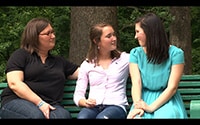Real Stories from People Living with Tourette Syndrome: Linda
Linda’s Story
This is the personal story of Linda and her son Lucas. Linda attended a CDC-sponsored program by the Tourette Association of America on Comprehensive Behavioral Intervention for Tics (CBIT).
”We first noticed that Lucas had tics in third grade. We had our suspicion that he may have TS [Tourette Syndrome] but we were frustrated with finding a doctor who knew about TS. The tics got worse; then we finally got a diagnosis when he was in the fourth grade.” As is sometimes the case, Lucas was also diagnosed with ADHD [Attention-deficit/hyperactivity disorder] and obsessive-compulsive disorder.
“He went from being a straight A student to not passing classes in middle and high school. Treatments were trial and error. Over 4 years we tried medication, which was a negative experience, and nutrition and diets, with no change. We also tried neuro-feedback which was helpful for a short time, but with no lasting improvement.
Meet two families and hear about their experiences living with Attention-Deficit/Hyperactivity Disorder and Tourette Syndrome.
Fortunately we had a friend in the TS community that recommended we go to a TSA family education program. In January, we attended the program and learned about a new way to treat TS –it was CBIT.” CBIT is a type of behavioral therapy that was developed for people with tics. Behavioral therapy teaches a person to become aware of their behavior and helps them change what they do in a very careful and systematic way.
“It was a huge blessing and we saw immediate improvement. Two days after Lucas started CBIT the first tic was gone. Each week another tic was gone. Now, at 15, he is basically tic-free for the first time since third grade. If we had known about CBIT 4 years ago, it would have made the past 4 years so much better. One thing I really like about CBIT is that Lucas is learning how to handle tics, so if new ones come up, he’ll be able to manage them on his own.“
“I wish pediatricians and teachers knew more about TS. It is so important to identify it early on and send families in the right direction. There is a good treatment, CBIT, and it worked for us.”
Research note: Two large scale studies of children and adults with TS showed that CBIT is a safe and effective treatment. But these studies also show that CBIT does not help everybody. CBIT is not a ‘cure’ for TS; rather, CBIT is a tool that when used appropriately can help people with TS manage their tics better and reduce the impact that tics may have on their lives. More information is needed to find out when it works best, and for whom.
Read more on what we know about CBIT.
CDC would like to thank Linda for sharing her personal story.
If you would like to share your personal story, please contact us at cdcinfo@cdc.gov
